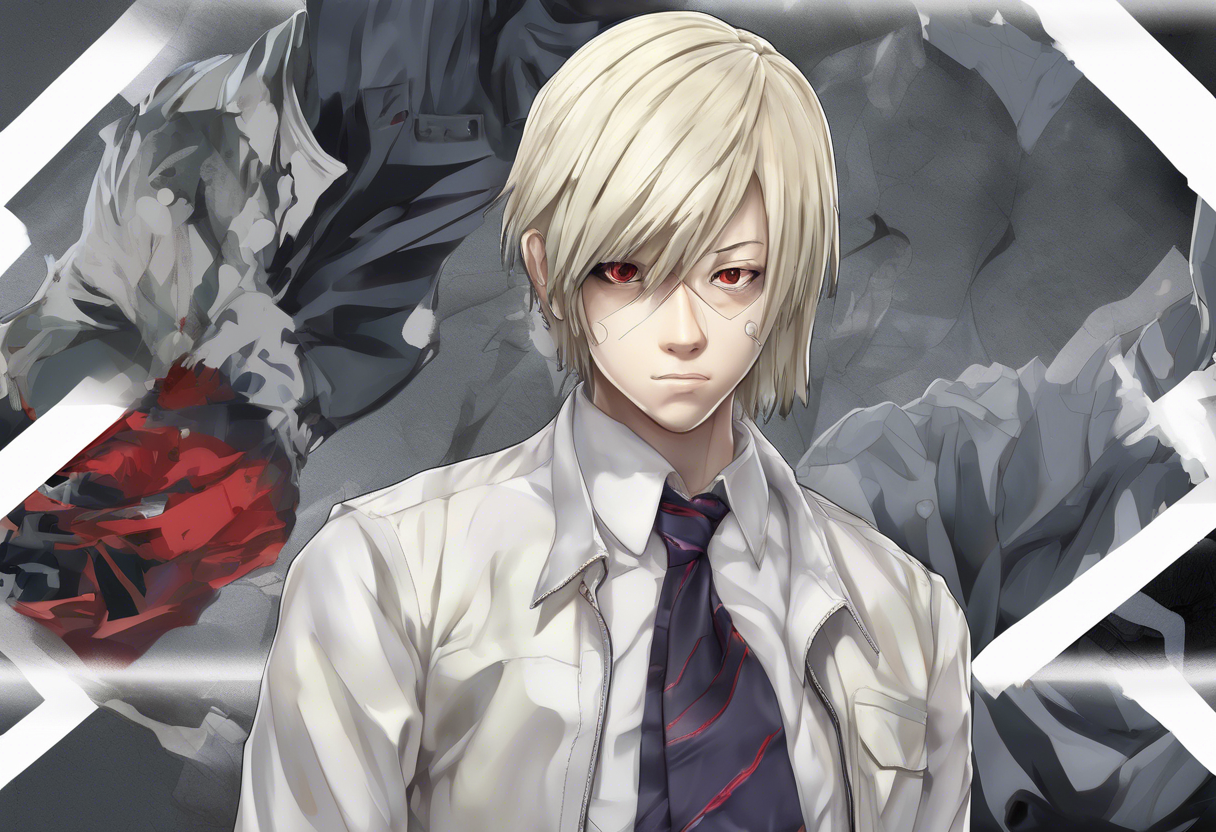Contents
Nashiro Yasuhisa: The Complex and Evolving Character of Tokyo Ghoul
Introduction
Nashiro Yasuhisa is a pivotal character in the anime and manga series "Tokyo Ghoul," created by Sui Ishida. She is an Artificial One-Eyed Ghoul, a product of the twisted experiments conducted by Dr. Kanou, which transformed her and her twin sister, Kurona, from humans into half-ghouls. This transformation involved the transplantation of a kakuhou (ghoul organ) from Rize Kamishiro, granting them the abilities and characteristics of ghouls.
Nashiro’s background is marked by her former life as a human and her subsequent transformation, which significantly impacts her identity and interactions within the narrative. Her defining attributes include her white medium-length hair, bluntly chopped bangs, and a distinctive long white cloak with a symbol resembling an eye on the hood. Her ghoul mask is a simple black and white horizontal striped mask with a hole in the right eye, reflecting her kakugan (the red, glowing eye of a ghoul) in her right eye[2][4].
Nashiro’s narrative function is multifaceted, as she and her twin sister Kurona play crucial roles in impeding Ken Kaneki’s pursuit of Madam A, a significant plot point in the series. Their actions and relationships with other characters contribute to the complex web of conflicts and moral dilemmas that define "Tokyo Ghoul."
Role in the Story
Nashiro Yasuhisa’s character arc is marked by her evolution from a cold and remorseless killer to a more compassionate and emotionally vulnerable individual. Initially, she and her sister Kurona are introduced as formidable opponents who challenge Kaneki and his allies. Their involvement in the plot is deeply intertwined with the experiments of Dr. Kanou and the broader conflict between ghouls and the Commission of Counter Ghoul (CCG)[2][4].
Throughout the series, Nashiro’s relationships with her sister Kurona and other characters are pivotal. Her bond with Kurona is particularly significant, as they often fight together, utilizing their coordinated attacks to overwhelm their enemies. This dynamic highlights their strength as a team and their deep emotional connection as twins[2].
Nashiro’s character also undergoes significant development as she confronts her past and the nature of her existence. Her interactions with Kaneki and other characters force her to question her identity and the morality of her actions. This internal conflict contributes to her personal growth and adds depth to her character[3].
Character Analysis
Nashiro Yasuhisa’s personality is complex and multifaceted. Initially portrayed as cold and remorseless, she gradually reveals a softer side, showcasing compassion and emotional vulnerability. This transformation makes her a more relatable and humanized character, despite her ghoul nature[3].
Her motivations are deeply rooted in her relationship with her sister Kurona and her desire to protect her. This protective instinct drives many of her actions and decisions, often leading her to confront formidable opponents. Nashiro’s strength lies in her physical prowess and her ability to wield her rinkaku kagune, which allows her to create powerful tentacles from her waist. However, her greatest strength is her emotional resilience and her capacity for empathy and compassion[2].
Despite her strengths, Nashiro also has weaknesses, particularly in her initial struggle to come to terms with her new identity as a half-ghoul. Her emotional vulnerability and the trauma of her past experiments often surface, making her a more nuanced and realistic character.
Themes and Symbolism
Nashiro Yasuhisa’s character is closely tied to several themes and symbols within "Tokyo Ghoul." One of the most prominent themes is the exploration of identity and what it means to be human. Nashiro’s transformation from a human to a half-ghoul raises questions about the nature of humanity and whether it is defined by biology or by actions and emotions[2][4].
The symbol of the kakugan in her right eye serves as a visual reminder of her dual identity and her connection to both human and ghoul worlds. Her white cloak and mask also symbolize her transition and her attempt to find a place within a world that is hostile to ghouls.
Another significant theme associated with Nashiro is the power of relationships and bonds. Her relationship with Kurona highlights the strength and depth that can be found in familial bonds, even in the face of extreme adversity.
Cultural Impact
Nashiro Yasuhisa has had a notable cultural impact within the "Tokyo Ghoul" fan community. Her complex character and compelling storyline have made her a favorite among fans, who appreciate her depth and the emotional resonance of her arc.
In terms of appearances in related media or merchandise, Nashiro has been featured in various forms, including figurines, cosplay, and fan art. Her unique appearance and intriguing character have inspired a wide range of creative interpretations and tributes.
Nashiro’s influence can also be seen in her impact on other characters within the series. Her interactions with Kaneki and other characters have shaped their own arcs and contributed to the overall narrative of "Tokyo Ghoul."
Critical Reception
Nashiro Yasuhisa has received positive critical reception for her complex and evolving character. Critics and viewers alike have praised her development from a cold killer to a more compassionate and emotionally vulnerable individual. Her character arc is often cited as one of the most compelling aspects of the series, adding depth and emotional resonance to the narrative[3].
However, some critics have noted that her character, along with Kurona’s, can feel somewhat overshadowed by other main characters in the series. Despite this, her significance in the plot and her emotional impact on the story are widely acknowledged.
Legacy
Nashiro Yasuhisa’s legacy in the world of anime is significant. She contributes to the evolution of character archetypes by embodying a complex and multifaceted personality that challenges traditional notions of good and evil. Her character arc serves as a powerful example of how characters can grow and change over the course of a series, adding depth and realism to the narrative.
Her influence can be seen in the broader anime discourse, particularly in discussions about character development and the exploration of identity and morality. Nashiro Yasuhisa remains a memorable and impactful character in the "Tokyo Ghoul" series, leaving a lasting impression on both the story and its audience.
References
- https://tokyoghoul.fandom.com/wiki/Nashiro_Yasuhisa
- https://aminoapps.com/c/virtual-space/page/item/nashiro/22Iw_IrjmP4B4pq2wnkElzXWQ4bMvq
- https://boo.world/database/profile/33006/nashiro-yasuhisa-personality-type
- https://myanimelist.net/character/119141/Nashiro_Yasuhisa
- https://weeabxtch.fandom.com/wiki/Touka







